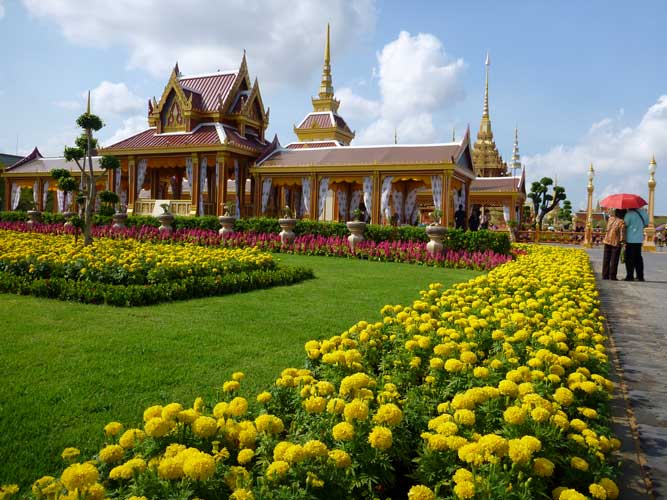
The cremation site of the princess opened to the public on the days after the ceremony, so I returned for a close look.
Friday April 13th was a lucky day in Thailand because it marked the start of the nation's biggest holiday, Songkran. People celebrate the end of the traditional old year and beginning of the new with a long holiday, new clothes, visits to temples to pour water on Buddha images, then free-for-all water battles in which everyone—willingly or not—can expect a soaking. Under an intensely hot sun, I began the day with a walk over to the elaborate complex of royal cremation buildings for a close look. The princess's funeral had been tremendously expensive, yet the Thais are very loyal to the king and royal traditions, and the elaborate ceremony had reinforced that aconnection. Formal gardens and potted flowers lined the entrance to the cremation grounds, then I entered the central area encircled by open-sided pavilions, some now sheltering shrines and photo exhibits of the princess. The public couldn't enter the high-ceilinged main hall nor the royal cremation building, though one could peek into the open-sided structures. Up close, one could see that the buildings had light-weight construction, yet they had much beauty, especially the cremation building with its inlaid colored glass and mirror work, ornate woodwork, gold paint, royal umbrellas, and guardian statues.

The cremation site of the princess opened to the public on the days after the
ceremony, so I returned for a close look.

The king, his family, and high-ranking officials sat in chairs (since removed)
in this hall
during much of the ceremony. High-ranking monks sat and chanted on the raised platform on
the left.

During the cremation ceremony, invited guests who had come to pay their respects to the princess assembled in
the many pavilions.
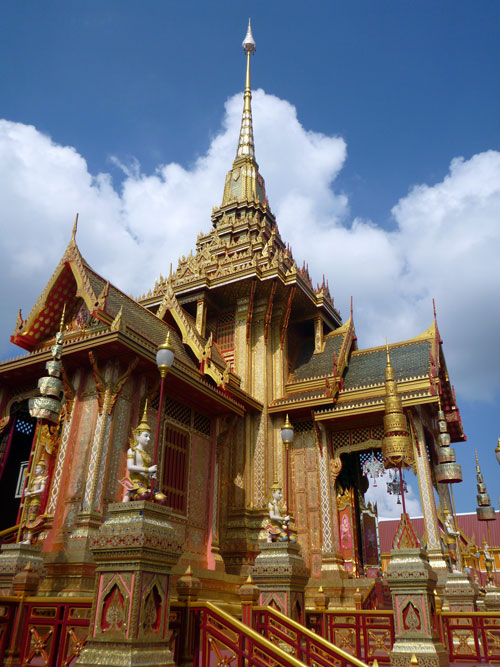
Up close, I could admire the intricate details of the cremation building.

A technician takes a look at the controls of the crematorium.
From the cremation grounds at Sanam Luang, I walked east along the grand and wide Ratchadamnoen Klang road past the Democracy Monument, which commemorates the 1932 Siamese coup d'état that led to the establishment of a constitutional monarchy. I continued a bit farther to Rattanakosin Exhibition Hall, a large and well-done history exhibit of the oldest part of Bangkok. I had visited a few days ago, and now returned to see a temporary exhibit on Songkran. Outside in the back, vendors had set up food stalls with traditional Thai foods; I tried one of the berry juice drinks, which was a shocking shade of blue. Next, I wandered over to nearby Loha Prasat temple with its distinctive metal spires. Here I watched visitors pouring water onto small Buddha statues that had been set into recesses along the base of the temple as part of the Songkran festival. I climbed up to the topmost chamber in which a bell-shaped container is said to protect a relic of the Buddha. Back on Ratchadamnoen Klang road, I stopped at a nearly empty Thai-Chinese restaurant for a bite to eat and ordered one of the few veggie items on the menu, an assortment of asparagus and other tasty vegetables neatly stacked like cordwood on a long plate. Despite the paltry audience, a woman and man alternated singing songs, and the woman belted out some oldie American songs "just for you." Back on the road, sidewalk vendors had great piles of water guns of all sizes for sale; the water wars would soon commence! Across Sanam Luang, I noticed people going in and out of the National Museum. Although closed, the museum had opened the hall of royal funerary chariots and palanquins, including those used in the recent cremation ceremony. Also, the Buddhaisawan Chapel was open, and I went inside to pay respects to the Buddha and admire the highly detailed paintings of the Buddha's life. Originally the National Museum site had been used for the vice-kings, and this chapel (actually a large temple) and other royal buildings have become part of the museum complex.

Sweet Colors in one of the booths behind the Rattanakosin Exhibition Hall
I think the colored bits are tapioca and are in a flavored syrup.

Pavilions and temples surround the metal-roofed Loha Prasat temple, said to be
the only one of this style in the world. Built in 1846,
it is 36 meters tall and has 37 spires, signifying the 37 virtues toward
enlightenment. The uppermost room shelters a relic of the Buddha.

To celebrate Songkran, visitors poured water on small statues of the Buddha that
encircled Loha Prasat temple.
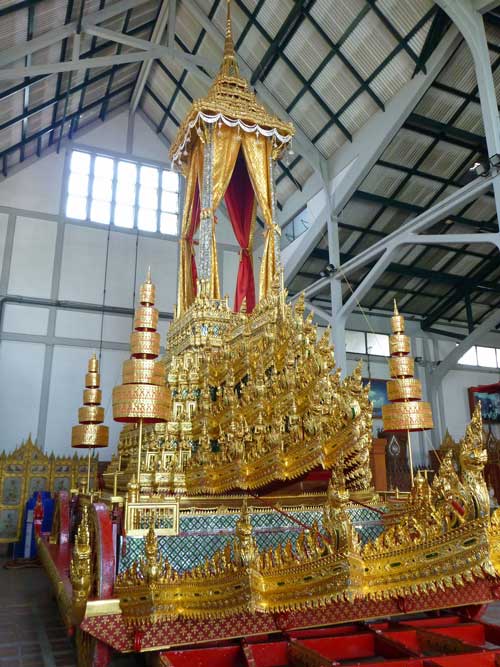
This is the Royal Chariot of Great Victory, built by King Rama I to carry the urn
containing his father
to the
cremation site ca. 1798. The royal family has used it ever since, including in
the recent cremation of the princess.
You can see it and other chariots and palanquins in the National Museum.
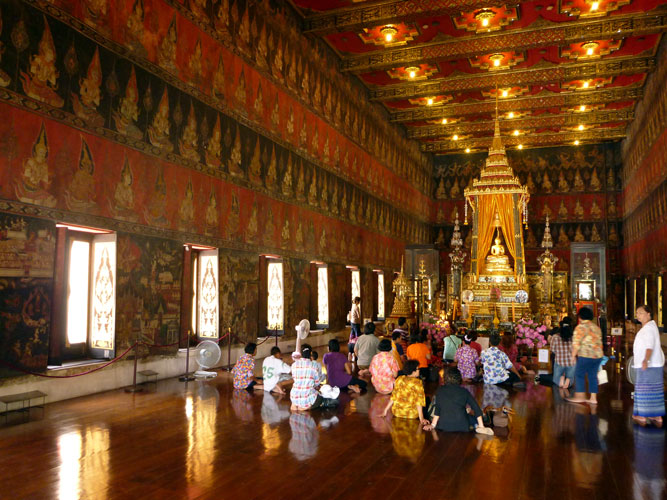
Also on the grounds of the National Museum, Buddhaisawan Chapel dates from 1795
and was built by
Vice-King Boworn Maha Surasinghanat. Murals along the lower wall inside depict
stories of the Buddha's life.
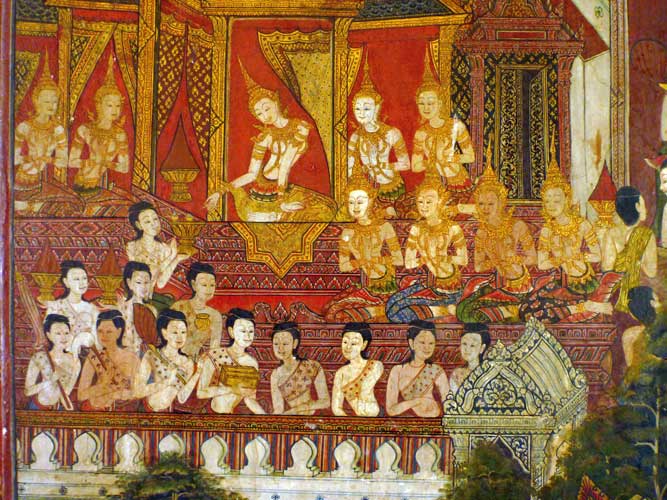
Detail of the royal wedding of Bodhisattva's parents in the Buddhaisawan Chapel
That afternoon, Michael Buckley and I set out on a mission—we were going to have a late lunch at the excellent Thai vegetarian restaurant, May Kaidee at 33 Samsen Road. Getting there and back would be the tough part, for the area had erupted into the Songkran water battles. Michael bought a water gun and we were off. Besides shooting water, we also shot people with our cameras. Michael had a tiny GoPro that he was keen to get some wet and wild video and I had my ruggedized little Panasonic DMC-TS3, also crucially waterproof. We didn't get far before the water guns, hoses, and buckets let loose in our direction. Some people used ice water, a shocker. All the water flying around cooled off everyone on the hot day. Some people carried containers of white clay paste and spread it over other peoples' faces, whether friends or strangers, but the streams of water everywhere soon washed off the face paint. We survived the gauntlet to the restaurant, found it open, then had a wonderful meal. On the way back, Michael had the crazy idea of heading into Khao San Road, said to be the scene of the most intense water battles, and it was. Michael found that his gun wasn't powerful enough, so he gave it to a kid and bought the biggest gun available, one that held two liters of water and could shoot fast and far. He delighted in trick shots: a short burst at someone, who would turn around and shoot back at someone else, thinking that person had been the source; meanwhile Michael had deftly stepped out of range. Water action became intense as we approached Khao San Road, and even more so when we arrived. Imagine a waterfall pouring on you from all directions; that's what it was like. Nobody was spared, nobody stayed dry. Even innocent travelers who had just arrived in Bangkok with their bags got soaked. Michael and I had such a good time that we ventured out into the water battles the following day, and had another great lunch at May Kaidees. You can experience a bit of the action on Michael's video at http://www.youtube.com/watch?v=eB9LuE4BTRA&feature=BFa&list=ULhClPoAz7hjc
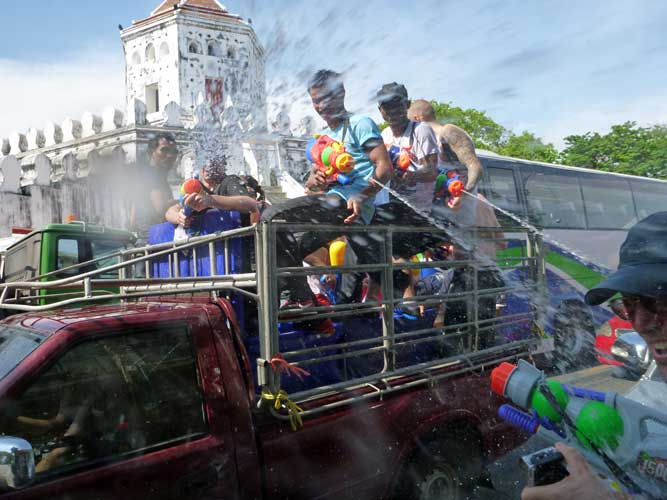
Watch out!
We're on Phra Athit Road and you can see Phra Sumen Fort in the background.
That's Michael Buckley at far right, armed with both a powerful water gun and a
little GoPro camera.
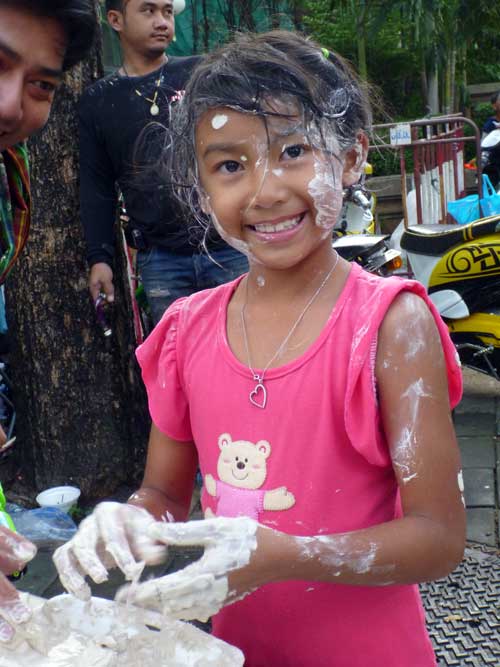
In the old days, Thai people would use clay as a cosmetic. Now it's mainly
smeared
on people's faces during Songkran. Who knows why? This girl is mixing up a
batch.
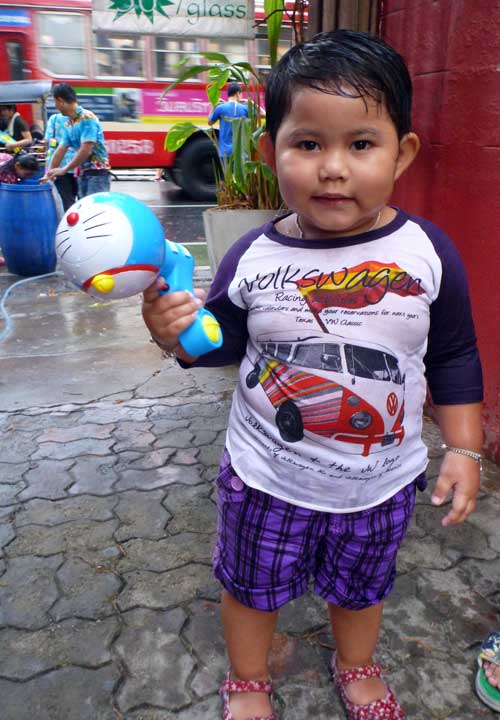
Even the little tykes got into the water fights, though they're kept away from
the heavy action.
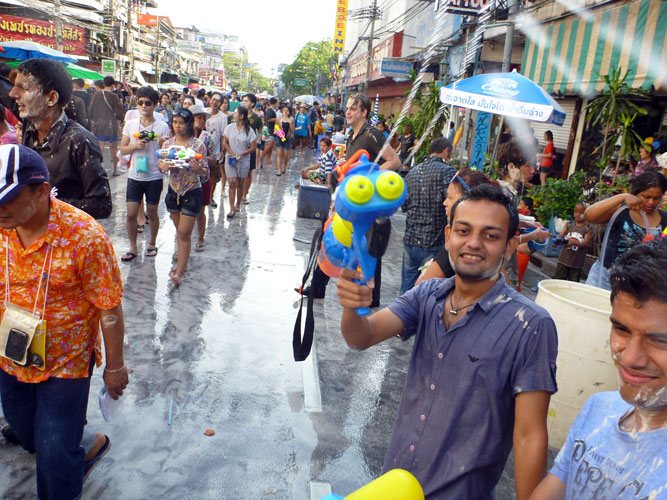
The closer we got to Khao San Road (backpackers' central), the fiercer the
action!

Michael Buckley heads into the thick of battle on Khao San Road with his big gun
and little GoPro camera.
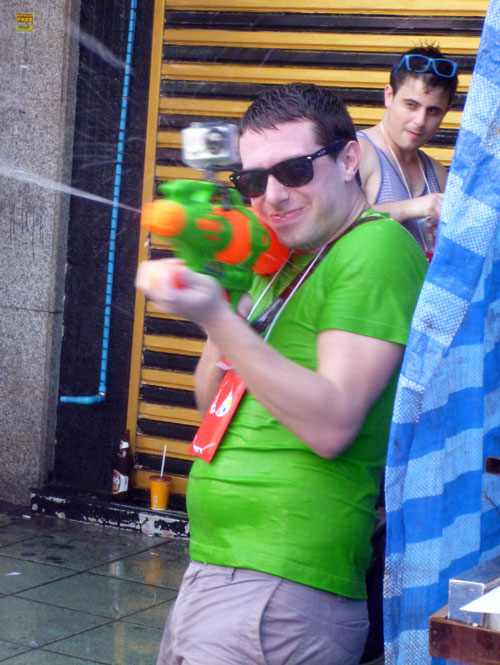
This determined tourist on Khao San Road has a GoPro camera mounted on his water
gun.
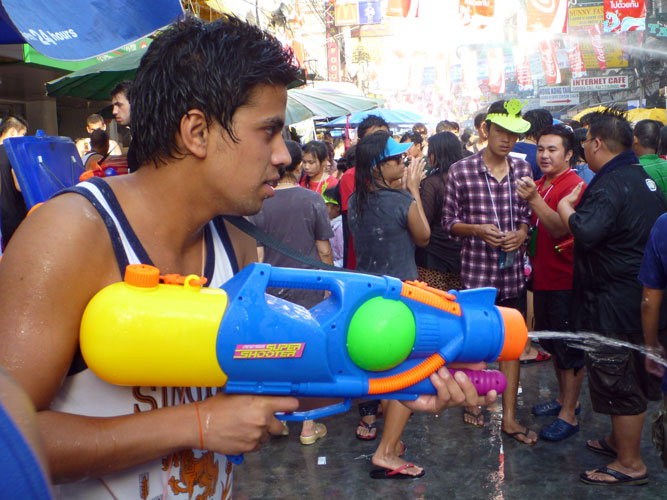
Water, water, everywhere, on Khao San Road. The water guns are Chinese made. The
yellow water reservoir probably holds about two liters;
the gunner pumps up the
purple handle for pressure, then pulls the trigger; the rest of the stuff on the
gun is pure decoration.

Dancing in the rain
What's a festival without singing and dancing? AirAsia sponsored these youngsters on Khao San Road.

By the end of the day on Khao San Road, Michael Buckley is a battle-hardened
veteran.
The week in Bangkok had gone by quickly, but on the 15th it was time to return to the U.S.A. The Songkran festival was still on, and this day was the traditional Thai New Year's Day. To be safe, I used plastic bags to protect the contents of my backpack and daypack in case I would have to run a gauntlet of water guns. Luckily the morning was calm, and I easily got a taxi to the the airport train station, then a train to the airport. I still got soaked though, not from water guns, but from sweat waiting in the station for the train! Flights on Cathay Pacific went well except for a wailing infant on the short first leg; my mistake had been to get a seat in the rear of the plane. The few hours between planes at Hong Kong's airport went quickly as I used the free wi-fi service to upload new text and photos for this website. On the long haul across the Pacific, I departed at half past midnight, then arrived at 10 p.m. on the day before. This time I had a seat in the front and the flight was blissfully quiet. Window shades were kept down nearly the entire time, making for a restful trip. Nearing San Francisco, the city appeared as thousands of tiny jewel-like lights outlining the coast, the bay, Golden Gate Park, and the bridges. The BART and MUNI trains eventually got me to my sister's abode in the city, where I got a second night's rest. All that snoozing seemed to reset my body clock so that jet lag never occurred.
Next up—a bicycle ride! This time in the United States, a country that I rarely cycle in. I plan to make a big loop from San Francisco to the American Southwest. You can see a route map of the entire journey along with the story and photos at www.crazyguyonabike.com/doc/GrandSouthwest.